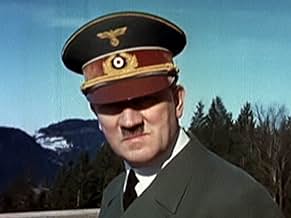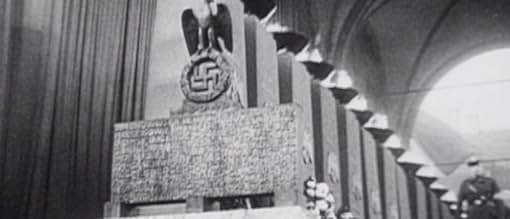Ajouter une intrigue dans votre langueThe Nazification of Germany from 1933 to 1945 told through a compilation of Nazi footage, newsreels, propaganda films and Eva Braun's home movies.The Nazification of Germany from 1933 to 1945 told through a compilation of Nazi footage, newsreels, propaganda films and Eva Braun's home movies.The Nazification of Germany from 1933 to 1945 told through a compilation of Nazi footage, newsreels, propaganda films and Eva Braun's home movies.
- Réalisation
- Scénario
- Casting principal
Galeazzo Ciano
- Self
- (images d'archives)
Albert Einstein
- Self
- (images d'archives)
Joseph Goebbels
- Self
- (images d'archives)
- (as Josef Goebbels)
Hermann Göring
- Self
- (images d'archives)
Heinrich Himmler
- Self
- (images d'archives)
Adolf Hitler
- Self
- (images d'archives)
Benito Mussolini
- Self
- (images d'archives)
Jesse Owens
- Self
- (images d'archives)
Joachim von Ribbentrop
- Self
- (images d'archives)
Avis à la une
10RandallB
This feature length documentary will knock your socks off ... if you're ever lucky enough to see it. If you have ever wondered how Hitler and his thugs wooed the Germans? Philippe Mora has assembled an incredible body of film footage here and let the material tell the story ... there is no narration, something Philippe does particularly well (see his next doco, BROTHER CAN YOU SPARE A DIME). He was even able to find Eva Braun's home movies of Hitler, mostly taken at Obersalzburg, and with the help of German lipreaders, bring them to life. Students of history will find it particularly enlightening. It is also horrifying. Most people didn't think Hitler was at all bad. Famous reporter Dick Brinkly singing the praises of Hitler in the mid 30s must be embarrassing. See it if you can. Pray it comes out on DVD one day.
10joel-28
Philippe Mora was the person who as a 19 year old film student discovered the now well known personal films of Eva Braun (that would make a fine film in itself). This fascinating color film footage is incorporated into this un narrated documentary along with a wide assortment of original Nazi newsreels and propaganda films to present life in Nazi Germany from 1933-45 as seen through the propaganda filmmakers (and Eva's) camera lens. A wonderful classical music score accompanies. This film is quite rare and is generally unavailable. I believe it was nominated for an award (or won an award). Nevertheless,if you get a chance to see it, buy it, etc, do it. It is the best documentary film on Nazi Germany of it's kind with much never before seen original footage.
Seeing this doc without a word from anyone, l'd realized a bit awkward, how l love documentaries, this one was an too unusual, all those old footages from the Third Reich in every places, endless speechs by the Fuher, all those political meetings, whatever happens l'll see it until to the end, and it arrives in worst ways, all those death bodies buried by tractors, all cities bombed and were quite often destroyed almost entirely, all those people trying running away from the soldiers or by buildings collapsed by fire, well l'd though poor german people who were compelled to believe in a such mad men, who ruled by force, all those barbarism ends up in a true massacre of sixty millions people in all Europe, Africa and Asia, that is serves as example forever, sorry for the last song mocking for german people, fully unnecessary, this war nobody won!!!
Resume:
First watch: 2019 / How many: 1 / Source: DVD / Rating: 7.5
Resume:
First watch: 2019 / How many: 1 / Source: DVD / Rating: 7.5
In the 1970s, historian Lutz Becker discovered a singular contemporary document: the so called "Home Videos" of Eva Braun. The 16 mm images show Adolf Hitler and his entourage in his country home Berghof at Obersalzberg. Becker turned to the young director Philippe Mora, who arranged the Home Videos with other footage from Germany in the 30s. The result was an unusual documentary: "Swastika". It premiered in 1973 at Cannes, where it caused a scandal. The movie had to be stopped halfway through, because the audience was irritated by the seemingly trivializing depiction of Hitler. In France, the movie role was stolen from a cinema and spread over the graves of Jewish Holocaust victims.
As you can see, "Swastika" was political dynamite. It was one major decision by Philippe Mora that caused all the fuss: He renounced every didactic commentary. There is no voice-over contextualizing the footage. Whoever watches this movie has to establish the critical distance alone. We have to find our own way through the propaganda Mora confronts us with. That makes for a challenging, captivating experience. The movie isn't completely neutral, though. There might be no verbal commentary, but there certainly is a stylistic one. For instance, in one scene we see Hitler taking a walk with a small girl, where Mora cuts repeatedly to pauperized ghetto children. Interestingly, these direct condemnations form the weakest parts of "Swastika". The movie is at its best when it just shows us the German delirium that was the Third Reich: cheering crowds, swastikas everywhere, sappy art, orotundity à la Riefenstahl, and finally Hitler presenting himself as a cool-headed and insightful leader. This madness ought to be a punch in the gut of every (reflected) viewer.
Then there are the color movies that Eva Braun recorded at Obersalzberg. We see a middle-class community enjoying itself, all while the Holocaust is raging. Among them: Hitler the personified evil, shown in all his banality. He's shockingly boring, standing around clumsily, almost dim-witted; talking about the Hollywood classic "Gone With the Wind", pondering the future of technicolor and playing with his dog Blondi. What do these images want to show us? What can they show us? The answer is: not much. At least nothing we shouldn't have known in the first place. Hitler wasn't some kind of monstrosity that came from outer space. He was a human like all of us. If we dehumanize him, we will never understand the catastrophe that was Word War II - insofar it is understandable at all. That's a simple yet important message the movie tells us rather clumsily at times. But "Swastika" shouldn't be reduced to that basic thesis. It shows more than it tells.
The juxtaposition of image and sound is especially remarkable. The love song "What Wouldn't I Do for That Man" ironically characterizes not only the relationship between Hitler and Eva Braun, but also the Hitler cult of the Germans. The use of Noël Coward's satirical song "Don't Let's Be Beastly To The Germans" after devastating pictures of mass extermination is downright cynical.
To this day, "Swastika" is a brave documentary that omits instruction (almost) entirely. The execution is a bit shaky, but you can't deny the unsettling atmosphere Mora's editing creates.
As you can see, "Swastika" was political dynamite. It was one major decision by Philippe Mora that caused all the fuss: He renounced every didactic commentary. There is no voice-over contextualizing the footage. Whoever watches this movie has to establish the critical distance alone. We have to find our own way through the propaganda Mora confronts us with. That makes for a challenging, captivating experience. The movie isn't completely neutral, though. There might be no verbal commentary, but there certainly is a stylistic one. For instance, in one scene we see Hitler taking a walk with a small girl, where Mora cuts repeatedly to pauperized ghetto children. Interestingly, these direct condemnations form the weakest parts of "Swastika". The movie is at its best when it just shows us the German delirium that was the Third Reich: cheering crowds, swastikas everywhere, sappy art, orotundity à la Riefenstahl, and finally Hitler presenting himself as a cool-headed and insightful leader. This madness ought to be a punch in the gut of every (reflected) viewer.
Then there are the color movies that Eva Braun recorded at Obersalzberg. We see a middle-class community enjoying itself, all while the Holocaust is raging. Among them: Hitler the personified evil, shown in all his banality. He's shockingly boring, standing around clumsily, almost dim-witted; talking about the Hollywood classic "Gone With the Wind", pondering the future of technicolor and playing with his dog Blondi. What do these images want to show us? What can they show us? The answer is: not much. At least nothing we shouldn't have known in the first place. Hitler wasn't some kind of monstrosity that came from outer space. He was a human like all of us. If we dehumanize him, we will never understand the catastrophe that was Word War II - insofar it is understandable at all. That's a simple yet important message the movie tells us rather clumsily at times. But "Swastika" shouldn't be reduced to that basic thesis. It shows more than it tells.
The juxtaposition of image and sound is especially remarkable. The love song "What Wouldn't I Do for That Man" ironically characterizes not only the relationship between Hitler and Eva Braun, but also the Hitler cult of the Germans. The use of Noël Coward's satirical song "Don't Let's Be Beastly To The Germans" after devastating pictures of mass extermination is downright cynical.
To this day, "Swastika" is a brave documentary that omits instruction (almost) entirely. The execution is a bit shaky, but you can't deny the unsettling atmosphere Mora's editing creates.
While the film has a great deal of footage of Uncle Adolph (maybe too much,) it was pretty tedious to watch. Kinda of like watching the home movies of someone one hates - in fact, this was _exactly_ what it was like for me!
I saw another reviewer said Eva Braun was hanging from a branch in a swimsuit and, being a "healthy puppy" (as my GF says,) I had to scan through and find those parts (3/4 of the way through for you other pervs) and they were strangely incongrous to the rest of the film, of course. She (Miss Braun) was quite a strong woman, and one could imagine her wrestling AH to submission, and him enjoying that...
TL; DR is watch it but scan through the parts without AH, EB, or cool old Benzes - or Jesse Owens.
Le saviez-vous
- AnecdotesThe provocative documentary was banned in Israel on the ground that it projects a sympathetic image of Adolf Hitler.
- ConnexionsFeatured in Krauts and Doubts: Swastika Revisited (2006)
Meilleurs choix
Connectez-vous pour évaluer et suivre la liste de favoris afin de recevoir des recommandations personnalisées
- How long is Swastika?Alimenté par Alexa
Détails
- Date de sortie
- Pays d’origine
- Site officiel
- Langue
- Aussi connu sous le nom de
- Swastika - hakkorset
- Société de production
- Voir plus de crédits d'entreprise sur IMDbPro
- Durée
- 1h 53min(113 min)
- Couleur
- Mixage
Contribuer à cette page
Suggérer une modification ou ajouter du contenu manquant



























